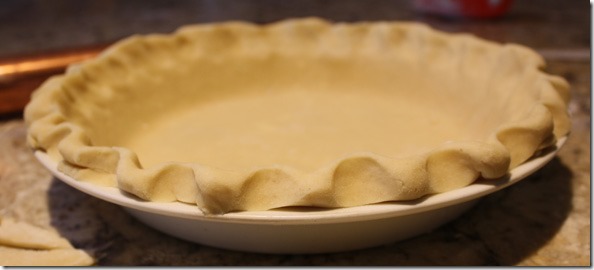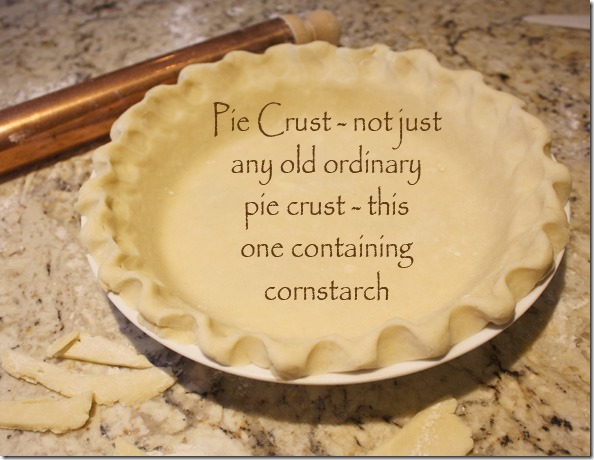One might think there couldn’t be anything “new” regarding pie crusts. But lo, behold, there is a pie crust that’s very easy, has a bunch of butter, but also cornstarch. Amazing.
If someone had given me a recipe for a new pie crust, well, maybe I’d have smiled, said thank you, and promptly set it aside and not even looked at it. But this one, oh gosh, what a mistake to not try it! This one came from Christopher Kimball, from his new venture, Milk Street. And there was a very big write-up about it in the magazine, so I input the recipe into my MasterCook software and didn’t think about it for awhile. I don’t make many pies.
But the other day, needing a dessert for my weekly bible study group, I was going through to-try recipes, and it just so happened I had rhubarb in the refrigerator. That led to a recipe, and that led to my needing a pie crust.
If you’ve followed my blog for awhile (it’s been nearly 11 years now I’ve been blogging) you likely have gone to my recipe index. It’s prodigious. I’m not bragging, truly I’m not. But sometimes when I’m actually writing in the additions to the index, I’m kind of blown away by how MANY recipes I have on this site. And I was particularly amazed at how many cakes are there. Obviously I love baking. And I use any occasion as an excuse to try something new. Occasionally I go back to a tried and true recipe (like my mother’s Crisp Apple Pudding that I made recently and used both apples and pears) but because I write a blog, well, one must keep truckin’ and try new recipes.
My next post will be the pie filling part – but today we’re just talkin’ about the crust. I’m not often lured into making pie crusts. They just seem like so much work. More work than I want to do. I’m not fond of making a pre-baked crust – more work with digging out the pie weights, getting them cleanly out of the shell, etc. In this case the sour cream-rhubarb filling was put into the raw crust and baked together (easier!).
The crust isn’t difficult, although you do have to briefly cook the cornstarch with water in the microwave until it’s hot and set. It gets cooled some, then stuffed in the freezer for 10 minutes to cool off. Then it’s added to the usual dry ingredients (flour, sugar and salt) in the food processor and pulsed until that mixture is smooth. Then you add the sour cream (only 2 tablespoons) and 10 tablespoons of butter. Once pulsed for a bit, it all comes together into a ball. It’s flattened into a 4-inch flat disk, wrapped in plastic wrap and chilled for an hour (or longer). I was on a time schedule, so I did 60 minutes.
But now, the crust – when I took it out of the refrigerator and began rolling it, it had a definite texture difference. It was supple and soft and the amount was perfect for my 9-inch pie plate. It didn’t roll out into that magical perfect circle that one would like (darn) but when I patched the dough in a couple of places, it adhered and was very easy to finish rolling. I rolled it up onto the rolling pin and gently let it down into the dish. It was easy to move, because, of course, I hadn’t centered it correctly, but the dough allowed me to do that without tearing or stretching it. Yea! I trimmed some of the edges off, then folded the 1/2 inch outer edges under and crimped with my fingers and the crust was DONE! It was easier than I thought. I didn’t freeze the dough-filled plate (as you would do if you wanted to blind bake it) and the finished pie was just fine – not overly browned even though I baked the pie at a different temperature than the suggested for a blind bake.
And oh, my. Is this crust tender! Even those tall, thick finger-crimped edges were as tender as could be. Sometimes when you make a wet kind of pie filling (like the sour cream rhubarb one I did) it makes the bottom crust soggy. Not this one. Why, I don’t know. I may just be making this pie crust anytime I need one in the future. The recipe says to make two and freeze one of the disks, which would be a great idea – just use within a month, though. You can also make the dough a couple of days ahead and keep chilled.
What’s GOOD: everything about this crust is a good thing! Easy to make. Easy to roll out. Easy to get into the pie plate. Baked perfectly. Bottom crust stayed a crust and wasn’t soggy. Easy to cut and get out of the pie dish too. Sometimes that first slice is a bummer. Not with this one, anyway. A day later when I had a leftover slice that had been refrigerated, the bottom crust was still firm and not soggy, and the chilled crust was tasty and flaky. Truly, this pie crust is a bit of a miracle for me!
What’s NOT: nothing at all – just one extra step to cook the cornstarch and water before starting and cooling it in the freezer for 10 minutes. You should chill the dough, too, so do plan a few hours ahead.
printer-friendly PDF and MasterCook 15/16 file (click link to open recipe)
* Exported from MasterCook *
Single-Crust Pie Dough with Cornstarch
Recipe By: Milk Street, 2016
Serving Size: 8
3 tablespoons water
2 teaspoons cornstarch
159 grams all purpose flour — (equals 1 cup plus 2 tablespoons)
2 teaspoons sugar
1/4 teaspoon kosher salt
10 tablespoons butter — WITH SALT, cut into 1/2-inch pieces and chilled
2 tablespoons sour cream
1. In a small bowl, whisk together the water and cornstarch. Microwave until set, 30 to 40 seconds, stirring halfway through. Chill in the freezer for 10 minutes.
2. Once the cornstarch mixture has chilled, in a food processor, combine the flour, sugar and salt and process until mixed, about 5 seconds. Add the chilled cornstarch mixture and pulse until uniformly ground, about 5 pulses.
3. Add the butter and sour cream and process until the dough comes together and begins to collect around the blade, 20 to 30 seconds.
4. Pat the dough into a 4-inch disc, wrap in plastic wrap and refrigerate for at least 1 hour and up to 48 hours.
5. When ready to bake, heat the oven to 375°F with a rack in the middle position.
6. On a well-floured counter, roll the dough into a 12-inch circle.
7. Hang the dough over the rolling pin and transfer to a 9-inch pie pan. Gently ease the dough into the pan by lifting the edges while pressing down into the corners of the pan.
8. Trim the edges, leaving a 1/2-inch overhang, then tuck the overhang under itself so the dough is flush with the rim of the pan.
9. Crimp the dough with your fingers or the tines of a fork, then chill in the freezer for 15 minutes.
10. To blind bake, line the chilled crust with foil and fill with pie weights. Bake until the edges are light golden brown, about 25 minutes, rotating the pan halfway through.
11. Remove the foil and weights and bake until the bottom of the crust just begins to color, another 5 to 7 minutes. Let cool on a wire rack for 1 hour before filling.
12. Once baked and cooled, the crust can be wrapped in plastic wrap and kept at room temperature for up to 2 days.
Tip: Don’t skip the sour cream; it’s key for a tender crust. And don’t skimp on the pie weights; use enough to come 3/4 of the way up the sides.
Per Serving: 214 Calories; 15g Fat (64.1% calories from fat); 2g Protein; 17g Carbohydrate; 1g Dietary Fiber; 40mg Cholesterol; 216mg Sodium.







hddonna
said on March 18th, 2018:
This will be fun to try–very unusual! And sour cream rhubarb sounds great. My grandma’s recipe for rhubarb pie–a custard one with meringue–is still my go-to, but I like to try other versions, too–I’ve got recipes for honey rhubarb, orange rhubarb, and rhubarb raisin pies. Also a rhubarb dessert that is more like a cream pie in a 13 by 9 pan, with a cup of cream in the filling. Can’t wait to see your recipe with sour cream.
It’ll be “up” on the blog in a few days . . . . carolyn
Toffeeapple
said on March 21st, 2018:
I wonder why the cornstarch has to be cooked before using, it sounds quite odd doesn’t it?
It probably explained it in the article, but I don’t remember – other than thinking it needs to be a viscous liquid, not dry, because dry cornstarch doesn’t act like much until it encounters liquid. Just a guess . . . carolyn t
Joan Markowitz
said on November 26th, 2019:
I just made this crust to use as an apple pie crust… but after making it I thought .. is this just supposed to be an open one crust?
The recipe makes enough for one crust. Period. But you can double the recipe and get enough for a double crust, if that’s what you meant. It’s a winner of a recipe, though. . carolyn t
Deb Frank
said on May 20th, 2024:
I noticed someone asked why the cornstarch slurry has to cool. That’s because you don’t want it warming your butter. You have to have really cold butter for a flaky crust since it is the cold butter releasing steam that lifts the dough and makes it flaky.
Of course! I remember my mother insisting about the ice water when she made a pie crust with shortening. Thanks for the reminder! . . . Carolyn T
Nancy B
said on November 21st, 2024:
The cornstarch mixture did not fully mix into the pie dough for me. Is had small pieces of it very obvious when I put it into the 4 inch ball. It was quite solid. I broke it into small pieces before using my food processor. Should I have done the butter in 2 small batches? I did them in 1.
Well, the only thing I can think of is that your cornstarch may have been old, so it clumped when you hydrated it? There should be no dry cornstarch once you added the water. Then, the cornstarch wet mixture should have been thoroughly mixed in when you added it to the food processor in Step 2. It needs to be completely invisible during that mixing process. You could give it a couple more pulses to make sure, although you don’t want to over-process it, either, which could make the dough tough. I hope those suggestions help. . . carolyn t
Holly
said on November 26th, 2024:
The cornstarch helps incorporate moisture into the pie crust for a flakier texture. It replaces the “add cold water” that most pie crusts call for. I’ve tried the recipe several times with great success for fruit pies and custards.
Thanks for the chemistry lesson, I think you have provided . . . this is a great pie crust and I, too, have made it several times with success .. . carolyn t
Diane Miller
said on March 16th, 2025:
Good morning! I’d like to try your pie crust recipe, can you do this by hand.
I suppose you could mix this by hand though it might take a bit of wrist/arm power to do it. Let me know how it turns out . . . carolyn t